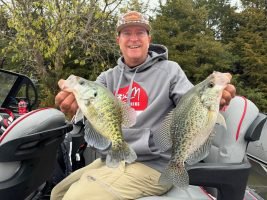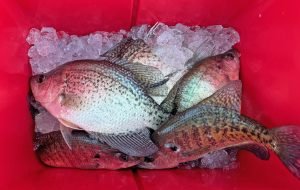(l-r) Russ Bailey with Brushpile Fishing and Kirby Ham both have popular YouTube
Channels that entertain and educate thousands of crappie fishermen every day.
Winter Secrets from Crappie Kirby
by Brent Frazee
Well-known guide Kirby Ham (a.k.a. Crappie Kirby) says crappie are a lot like quail in the winter months. He says both species like to stay near their food source in the cold. They “covey up” when conditions get harsh and especially relate to heavy cover when temperatures plummet. They believe in strength in numbers.
That is why winter is Ham’s favorite time to fish for crappie.
“A lot of people like fishing for crappie during the spawn, but that’s my least-favorite time,” said Ham, who runs the Crappie Kirby Guide Service in Olathe, Kansas. “There are too many variables in the spring that can throw things off.
“I’ll take the winter any day. The colder it gets, the more the crappie group up. I’ve found schools so big that I couldn’t fathom how many fish there were.”

Once, such a phenomenon was somewhat of a secret in Kansas. Ham remembers a time when he and a few of his friends were the only ones on some Kansas reservoirs in the winter.
“Years ago, it would be me, a guy we called Meat Locker and another guy we called Nitro Bob, and we would race to see who could get to the best spot first,” Ham said. “We didn’t have the electronics we do today so we really didn’t know why they were there. But some of those spots would produce limits of fish just about every time out.”
Contrast that to today, when Ham and many other crappie fishermen have the advanced electronics to tell them why those fish are there. Those advanced electronics, especially forward-facing sonar, draw a picture of why winter is such a great time to fish for Kansas crappie, or crappie anywhere for that matter.
Dozens of boats now dot popular crappie lakes such as Milford, Melvern, Hillsdale, Perry, Clinton and Pomona on winter weekend days. And live wells on those boats are often brimming with crappie. There are days when you can almost mark the river channel by viewing the way the boats are positioned.
Ham said gizzard shad use those channels as a travel way when the water gets cold. The brush or other cover along those channels can attract big schools of crappie waiting to ambush those baitfish.
Ham showed how it works during a recent Outdoor Communicators of Kansas conference at Milford Reservoir two hours west of Kansas City.
He used his electronics to locate brush piles in about 20 feet of water not far from the channel. He used a rig similar to a drop-shot, in which a 3/8th-ounce sinker was tied to the end of the line and a hook was tied with a loop knot several inches above that. He baited that hook with a lively minnow and lowered it to the bottom.
He watched on his Garmin LiveScope as the suspended minnow immediately attracted the interest of a crappie. Seconds later, that fish was in the livewell.
Ham continued to work over that school until it was time to move onto another brush pile. Before long, he had a healthy school of fish in his livewell and video footage that he can use for his YouTube channel.
“Presentation is everything in cold-water fishing,” Ham said. “Too much jigging or action on your baits will often scare the fish away. It doesn’t look natural.”

Ham often drops his bait slightly above the fish he sees on his forward-facing sonar (FFS) and holds it motionless. If the fish doesn’t react, he slowly lifts it to imitate something trying to escape. That often does the trick.
“It can be a game of inches,” Ham said. “If you’re below the fish, you won’t get them to hit. And if you’re too far above the fish, the same way. They aren’t going to chase a bait in the winter. They’re in an almost hypnotic phase. But if you put a bait in front of them, they’ll hit.”
The winter fishing often begins to heat up in the third or fourth week of November, Ham said. He will use live bait until the first or second week of December, utilizing his bottom bumping or drop-shot technique.
Later, he will go to plastic jigs, primarily Crappie Magnets, which feature a split-tail design.
Ham often starts by using the chart function on his electronics and looks for the water depth most conducive to winter fish.
“That eliminates a lot of water,” he said.
Ham generally targets a zone from 15 to 25 feet of water. In early winter, he looks for intersections of where the crappie had been in fall. That could be a bridge pillar, standing timber along a channel or a brush pile at the mouth of a cove where they had been shallow, feeding shad.
As the baitfish move deeper, the crappie follow them. That’s when Ham will search for something “different” along a channel.
Brush, stumps or rock piles will serve as ambush points for the crappie. Bends in channels also can be productive.
When Ham is bottom bumping, he likes to use 6-pound test Gamma line, a copolymer blend of mono and fluorocarbon. He uses a 7-foot B’n M medium-light rod that is sensitive, yet has enough backbone to bring a fish straight up instead of allowing them to get tangled in the brush.
He uses high-end reels that are lightweight and have a good drag system.
Safety is a priority when fishing in the cold. Ham tries to always fish with a friend. And he bundles up in high-tech insulated clothing.
I’ve been out there on some pretty nasty days in December and January,” Ham said. “But when there’s open water and the fish are biting, it’s hard to stay inside.”
Even when he stays inside, he is busy. Ham is a popular DJ and radio personality in the Kansas City area.
He hosts a YouTube fishing show called “Fish, Eat, Live,” and has a weekly radio show called “Right Outdoors with Crappie Kirby” on KCMO Talk Radio, 710 AM in Kansas City.
“I have a pretty busy life,” he said. “Fishing is my way to relax and decompress.”
Brent Frazee is an award-winning freelance writer from a suburb of Kansas City, Mo. He was the outdoors editor for The Kansas City Star for 36 years before retiring in 2016. He continues to freelance for websites, magazines, newspapers and tourism agencies.


